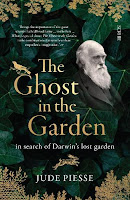 |
| (Amazon UK link) |
It’s not fiction; the cover features an image of Charles Darwin, and the subtitle is ‘in search of Darwin’s lost garden’. There are several positive brief reviews on the back, and it’s supposedly about Darwin’s childhood and his garden. The author’s theory is that this garden, where he grew and nurtured all kinds of different things, was instrumental in providing the background to his later research into different species, and his discovery of natural selection.
I’m sure there’s a lot of truth in this claim. It could perhaps have been quite interesting as a biographical story, following the young Charles, getting to know him and his sisters. But it’s not written that way. The author is an academic, and much of the book reads like a formal thesis - complicated, long-winded, and with a great deal of technical information (about the cultivation of ferns, for instance). There are references to diaries and letters, giving authenticity. Perhaps, to a botanist, or a student of Darwin, it might be a valuable resource.
With the apparent aim of making the book more accessible to ordinary folk, it interrupts academic treatises, here and there, with a few personal anecdotes. Sometimes the author expresses great excitement at discoveries in diaries she’s been able to access - her research is very thorough - and sometimes it’s regret, in the time she’s spending apart from her two young daughters. I found these personal snippets quite interesting and revealing, but they’re few and far between. She names her daughters, but doesn’t tell us enough about them for me to feel much empathy for them.
The book also seems to follow tangents in all kinds of directions. So there are sections about Charles’ sisters, left behind when he starts on his travels, and the regularity (or otherwise) of their correspondence. There’s a section about a portrait and extensive detail about when it might have been painted. There are biological references to things in the Darwin garden, and a section about bees… and endless different historical figures, written not with any chronological sense, but introducing them here and there when they seem to be at least loosely relevant. I had no idea who most of them were, and gave up trying to remember any names (other than the three sisters) after a couple of chapters.
I wanted to like this book, but I couldn’t find anything to hold my attention. My mind kept wandering; I would turn pages having not taken in anything. I skimmed paragraphs that became far too technical botanically or biologically and sometimes found myself skimming several pages in this way, looking for something of human interest.
I don’t think I’m unintelligent; admittedly I have no interest at all in botany, but I had hoped to learn a bit more about the people involved in this book. It’s extremely popular and highly reviewed. I thought I would be in the minority in our local group, finding it long-winded, rambling and dull - only to learn that others also found it a struggle, and at least one found it so tedious that she gave up. One by one they dropped out, until there was nobody left to discuss it so we had to cancel.
I may be shouted down for my opinions, but then no book is going to please everyone. It's thorough, it's well researched, and for those with visual imaginations, the writing may bring the places alive. However, as should be clear from the above, I wouldn’t personally recommend this book, unless you’re a passionate fan of Darwin, familiar with the places described in lengthy detail, and interested in the technicalities of botany, biology and breeding.
No comments:
Post a Comment